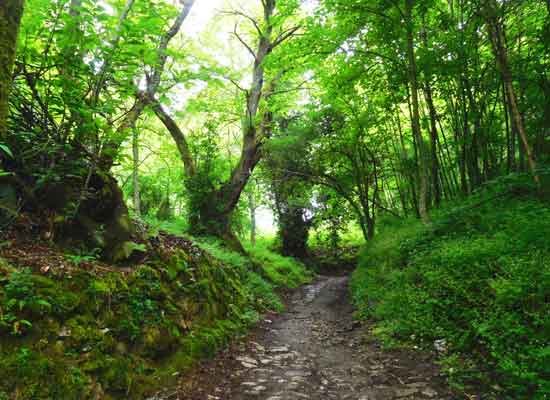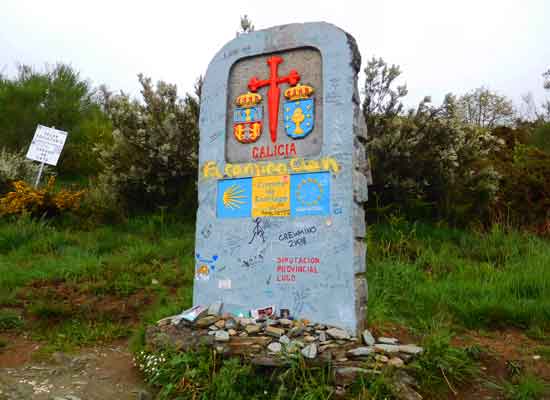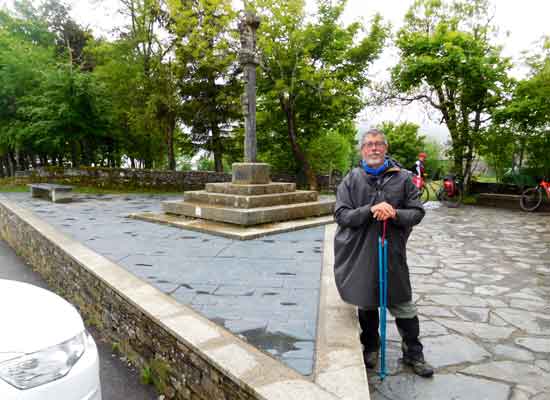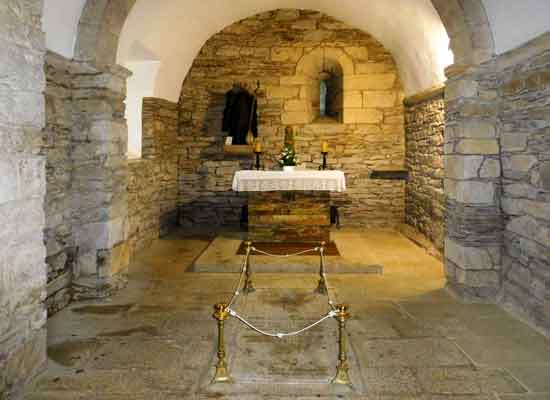Step by Step along The Way of Saint James
From Villafranca del Bierzo to O Cebreiro
5 June 2018
Stage 26 – 29 km

The stage I am about to tackle, the twenty-sixth, will be a real test for me.
After many days of suffering due to severe shin pain, I hope not to experience any further issues and to complete today’s itinerary, which spans almost thirty kilometers and has an elevation gain of about one thousand meters.
From today onwards, I also resume carrying the eight-to-ten kilos of my backpack on my shoulders.
In the past few days, to avoid adding strain to my legs, I had entrusted the heavy burden to a courier service.
With a gloomy, drizzly sky and the usual chilly morning air that once again requires warm clothing, we start walking around 6:30.
Considering the long and demanding stage ahead, I would have preferred to leave half an hour earlier. Unfortunately, the internal alarm clock that wakes me up naturally each day was late this morning.
Evidently, after so many days on The Way, fatigue is beginning to take its toll, and my body is asking for a bit more rest.
This morning, our small group of pilgrims includes a new young Belgian friend, Amandine.
Leaving Villafranca del Bierzo, we are marked out of the town center by yet another Roman bridge; in this case, the ancient structure is made of thick stone walls and three large arches.
At the beginning of the bridge over the río Burbia, a statue of a pilgrim, characterized by the symbols of Saint James—the staff, the shell, the gourd, and the cross of Santiago carved on the chest—greets the passersby.
While darkness still dominates, the passage over the bridge is made particularly evocative by the golden-yellow light of the street lamps and the deep blue color the sky takes on with the first glimmers of dawn.
The beauty and solitude of the mountains framing our journey, covered in dense, tall vegetation, tell tales of distant times past.
These places were a favored refuge for many hermits, giving the area a reputation as a first-class spiritual center.
For nature lovers, this wonderful region offers various trails that climb the hills and cross its valleys.
For a good first half of the stage, despite passing through a beautiful landscape, those of us walking The Way towards Santiago de Compostela are somewhat penalized by having to proceed alongside the N-VI highway and passing under some imposing spans of the Northwest Motorway.
On one side, we have the passage of motor vehicles, which somewhat detracts from the poetry of our walk, while on the other, the slow flow of the río Valcarce accompanies us, winding almost parallel to the asphalt strip we follow.
Fortunately, the road traffic is not very heavy, and between one passing vehicle and the next, there are long stretches of silence.
It is during these moments that we can hear the gentle sound of the placid waters as they slip over the rocky riverbed. It almost feels like listening to the stories of an "old sage" who, calmly and in detail, recounts the events witnessed over the course of its existence.
The river has always symbolized time flowing and slipping away, and this makes me think that the old río Valcarce holds the tales of the many pilgrims who have walked beside it over the centuries.
As we walk, we can clearly perceive the incline of the ascent, although the steepest stretch will come in the final part of the route.
The day remains overcast, and at times, the rain joins us.
We make our first stop of the day at Trabadelo.
It’s about nine o’clock, and it’s time to rest at a bar, both to take care of physical needs and to eat something, as the frugal breakfast we had at the hostel this morning has long since been burned off.
A very brief detour from the main road in Trabadelo allows me to take a look at the village’s only monument, the small medieval church dedicated to Saint Nicholas.
The dominant feature of the simple façade is the bell tower, structured as a tall wall with three levels, the top one ending in a peak. The bells are housed within three semicircular arches.
The architecture of this church is typical of rural religious buildings in the region and is often replicated.
After Trabadelo, the route we follow continues to intertwine with the río Valcarce, the highway, and the motorway.
In the meantime, I’ve lost track of the friends I set off with this morning.
They’ve all gone ahead, while I prefer to proceed more slowly. By not pushing my legs too hard, I hope to avoid new physical problems, especially today when I’ve started carrying my backpack again.
Walking at a leisurely pace is also a way to enjoy the landscape more, prioritizing the pleasure of the journey over the destination.
At 10:30, I arrive in Vega de Valcarce.
According to legend, this small village was founded by a family from Galicia who, before building their home, lived inside a chestnut tree.
The town center has a medieval layout and is characterized by the church of La Magdalena. Built in the 17th century, the church has been renovated several times over the centuries, with the latest restoration completed in the 1980s.
The building has a single nave, and its square-shaped bell tower features double semicircular arches at the top on each side.
On a hill not far from the village stands the Castillo de Sarracín, dating back to the 10th century, which has survived in reasonably good condition.
To visit it would require a detour, adding at least a couple of kilometers to the route.
However, since today’s stage is already quite long and challenging, I decide to skip the visit and press on.
At Ruitelán, I stop for a break at the Omega Café-Bar. It’s eleven o’clock, and after four and a half hours of walking, I’m really craving a tortilla.
Inside the cozy establishment, I meet Anna, the French teacher who had previously walked with Juanì and is now with a new companion on The Way.
I ask her for news about our mutual Spanish friend, who fell behind by a few stages, but she too has lost track of her several days ago.
After another hour of walking, I arrive at Las Herrerías. I’ve now reached 675 meters of altitude, practically halfway to the maximum elevation I’ll need to climb to complete this stage.
There are still nine kilometers to go, and the hardest part of the climb starts here: the steep section that leads to the 1,300-meter-high O Cebreiro.
Las Herrerías is also the point where The Way of Saint James finally moves away from the main roads.
Even though the route continues on paved roads for a while longer, my slower pace has become much more pleasant without the constant noise of motor vehicles.
Only the weather refuses to relent, occasionally surprising me with brief downpours.

Despite the steep incline, the surrounding landscape rewards me for the effort of the climb.
As I advance, I encounter one green hill after another, covered in thick vegetation—so dense that I can barely glimpse the sky above me and thick enough to act as an umbrella, shielding me from the rain.
Majestic centuries-old chestnut trees, pine forests, and vineyards are a preview of what lies ahead in the final stretch of the French Way as it crosses Galicia’s verdant region.
This area is dotted with tiny villages featuring ancient stone houses, monasteries steeped in history, old forges that hint at a former industrial economy, and farms where freely grazing animals are synonymous with genuine local products.
The chestnut is the star of the Bierzo region, so important that it is celebrated in autumn with the “Magosto,” a festival dedicated to it that takes place throughout the area.
At dusk, known as the “tardiña,” people gather around fires, and as drums play, chestnuts are roasted and eaten hot, accompanied by potatoes and good wine.
At half-past twelve, I reach La Faba.
Here, I find Rocco and Amandine comfortably seated next to a watering trough, playing with a large, long-haired dog.
We start walking together again.
The route leaves the paved road behind and continues along a dirt path.
We first walk through a dense forest, and once we emerge, the landscape opens up, revealing sweeping views of the valleys below.
By now, we’ve climbed higher, and with the fog—often present in these areas—thankfully absent, we can see the forests we’ve already crossed.
Once again, vibrant green dominates the scenery, although occasional bursts of contrasting color appear here and there, thanks to the white blooms of a particular type of broom.
After another hour of climbing, we arrive at La Laguna.
This is the last village in the province of Castilla y León before reaching the border with Galicia, just about a kilometer away.
As I walk, now nearing the end of this demanding stage, my thoughts turn once more to the ancient pilgrims who took this same path without the conveniences we have today, also enduring the challenges of harsh winter weather.
In winter, this region is covered in deep snow, daylight hours are limited, and fog blankets everything. Add to this the cold, steep climbs, and who knows what other hardships.
They say—faith moves mountains—but in this case, I would say—faith moved the pilgrims through these “difficult” mountains.
In the early centuries of the second millennium, a massive pilgrimage saw a steady flow of people crossing these rugged areas, driven by religious devotion and the firm resolve to keep a promise.
Thinking about this, I feel fortunate that my only discomfort during this climb is a bit of light rain.
Moreover, my legs are holding up well, and I’m relieved to feel no pain.

At 13:40, I arrive at a large stone marker that signals the entrance into Galicia.
This is another significant moment in my journey along The Way.
After crossing Navarra, Rioja, and the endless Castilla y León with its “mesetas,” it is deeply satisfying to have made it this far and to feel that my efforts have been rewarded.
From this point, only 160 kilometers remain to reach Santiago de Compostela—little compared to the 600 I have already walked.
In Galicia, The Way is marked by distinctive milestones: in addition to featuring the symbols of Saint James, these markers bear two brass plaques.
One displays the UNESCO emblem, recognizing The Way as a “World Heritage Site” in Spain, while the other indicates the remaining kilometers to Santiago de Compostela.
From the border of Galicia, only a little over a kilometer remains to complete today’s stage.
The path is unpaved, and the climb delivers its final challenges: in this short stretch, the elevation gain is nearly one hundred meters.

At exactly 14:00, I conquer O Cebreiro.
Arriving in the village, I come across a roadside cross, and not far from it, a simple monument.
The monument depicts a map of Europe with a dense network of routes leading to Santiago de Compostela, starting from the farthest points of the continent.
We stay at the Albergue do O Cebreiro, run by the Xunta de Galicia and located at the village’s exit.
While checking in, we experience ten minutes of panic because Rocco cannot find his ID card, without which he cannot be admitted to the hostel.
After imagining several scenarios about where he might have left the document—and just before heading to the Spanish Civil Guard to report it lost—he discovers that he had it with him all along.
One theory he considered before finding it in his backpack was that he had left it at the hostel in Villafranca del Bierzo.
In that case, the only solution would have been to take a taxi to retrieve it and then return.
***
The hostel is public and costs just 6 Euros.
Renovated about ten years ago, it is a well-organized structure.
It has 104 beds and a good number of showers and toilets.

Around 17:00, we head out to explore the charming village of O Cebreiro.
Both the houses and the cobblestone streets are entirely made of stone.
The village’s scenery, which transports us to an ancient era, is made even more enchanting by the mist that, as often happens here, has just rolled in and enveloped everything.
We visit the igrexa de Santa María a Real do O Cebreiro, a 9th-century church counted among the oldest monuments on The Way of Saint James.
(Note that here “church” is not called “iglesia” as in Spanish but is instead referred to in Galician as “igrexa.” This is an example showing that Galicia has its own language, influenced by Portuguese, and as a result, many terms differ from the official Spanish language spoken elsewhere in Spain.)
The ancient church, dedicated to the Virgin Mary, was built in the pre-Romanesque period and consists of three naves.
The beauty of this structure lies in the primitive simplicity of its architectural features.
Inside, it houses the “Chalice of the Miracle,” a cup linked to a miraculous event.
It is said that, on a winter day in the year 1300 (exact date unknown), a farmer came to the church to attend Mass, braving an exceptional snowstorm.
The priest, who did not expect anyone to come on such a dreadful day, showed a clear lack of faith, charity, and tact by mocking the farmer, thinking the fool had made all that effort merely to eat some bread (the host) and drink a sip of wine from the chalice.
At the moment of the Eucharist, however, the host turned into flesh, and the wine became blood.
Thanks to news of this miracle, the sanctuary gained several papal bulls and royal privileges.
The miraculous chalice is even depicted on Galicia’s coat of arms.
The two protagonists of the story, the priest and the farmer, were buried in the same church near the site of the miracle.

Another tomb inside the church is that of Don Elías Valiña Sampedro, the parish priest of O Cebreiro who, in the early 1980s, reconstructed the entire route of The Way of Saint James after studying it for a long time.
Starting from Saint-Jean-Pied-de-Port and using a paintbrush and yellow paint, he marked the path with arrows, creating the very symbol used today to guide pilgrims along the route.
This priest can be considered a visionary, having foreseen that his studies and efforts would lead countless people along the medieval road from France to Galicia, ending at the tomb of the Apostle James.
The year 1993 is seen as the revival of The Way of Saint James.
Unfortunately, Don Elías did not live to witness the fruits of his labor, as he passed away prematurely just four years earlier.
After visiting the church, we stroll through the narrow streets of the village.
The cold is biting and does not encourage lingering outdoors for long.
We decide to return to the hostel but first stop to buy something for breakfast the next morning.
In the evening, we go for dinner at Mesón Antón, a cozy little restaurant, unsurprisingly filled with many other pilgrims like us.
Of course, I don’t miss the opportunity to try the local specialties: stuffed peppers with cod, a mixed grilled meat platter, and, to finish, a slice of cake—the famous “Tarta de Santiago,” a typical dessert of Galician cuisine.
The distinctive feature of this cake is that it contains no flour but instead uses ground almonds, along with eggs and sugar, all in equal parts.
The decoration on the cake, created with powdered sugar, is the “Coquille Saint Jacques,” also known as the Cross of Santiago, one of the symbols of the pilgrimage.
| © Aldo Lardizzone 2020 |  |
CREATIVE COMMONS |



